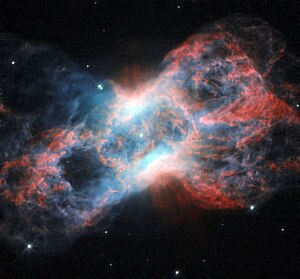astro.wikisort.org - Galaxy
NGC 7026 is a planetary nebula located 6000 light-years away, in the constellation of Cygnus. This image was produced by the Hubble Space Telescope using the Wide Field and Planetary Camera 2 aboard.
| Emission nebula | |
|---|---|
| Planetary nebula | |
 Composite image using optical images from the HST. | |
| Observation data: J2000 epoch | |
| Right ascension | 21h 06m 18.237s[1] |
| Declination | +47° 51′ 07.15″[1] |
| Distance | 6000 light years ly |
| Apparent magnitude (V) | 15.33B[1] |
| Constellation | Cygnus |
| Designations | GSC2 N0331022145839, 2MASX J21061823+4751071, PN ARO 59, CSI+47-21046, GT 2104+476, PK 089+00 1, PN VV 260, DO 39213, HBHA 4703-62, PLX 5080, PN VV' 542, EM* CDS 1218, HD 201192, PLX 5080.00, [KW97] 55-39, GCRV 13271, IRAS 21046+4739, PN G089.0+00.3, [TGC96] 2104+4739 |
The central star of the planetary nebula has a spectral type of [WO3], indicating a spectrum similar to that of an oxygen-rich Wolf–Rayet star.[2] An analysis of Gaia data suggests that it is a binary system.[3]
References
- "Search results for NGC 7026". Astronomical Database. SIMBAD. Retrieved 29 May 2012.
- González-Santamaría, I.; Manteiga, M.; Manchado, A.; Ulla, A.; Dafonte, C.; López Varela, P. (2021). "Planetary nebulae in Gaia EDR3: Central star identification, properties, and binarity". Astronomy & Astrophysics. 656: A51. arXiv:2109.12114. Bibcode:2021A&A...656A..51G. doi:10.1051/0004-6361/202141916. S2CID 237940344.
- Chornay, N.; Walton, N. A.; Jones, D.; Boffin, H. M. J.; Rejkuba, M.; Wesson, R. (2021). "Towards a more complete sample of binary central stars of planetary nebulae with Gaia". Astronomy & Astrophysics. 648: A95. arXiv:2101.01800. Bibcode:2021A&A...648A..95C. doi:10.1051/0004-6361/202140288. S2CID 230770301.
External links
 Media related to NGC 7026 at Wikimedia Commons
Media related to NGC 7026 at Wikimedia Commons
На других языках
[de] NGC 7026
NGC 7026 (Cheeseburgernebel) ist ein planetarischer Nebel im Sternbild Schwan. NGC 7026 sind verschiedene, beieinanderliegende bipolare Ausbuchtungen, die von einer ringartigen Tailie ausgehen. Im Zentrum sitzt ein wasserstoffarmer WC-Stern. Anhand der Ausdehnung und Ausdehnungsgeschwindigkeit geht man von einem Alter des Nebels von unter 1.000 Jahren aus. Eine Röntgenbeobachtung mit dem XMM-Newton zeigt eine hohe Emission in den Ausbuchtungen, die vermutlich von etwa einer Million Kelvin heißem Plasma in diesen Bereichen des relativ jungen Nebels herrührt.[3]- [en] NGC 7026
[ru] NGC 7026
NGC 7026 (другое обозначение — PK 89+0.1) — планетарная туманность в созвездии Лебедь.Текст в блоке "Читать" взят с сайта "Википедия" и доступен по лицензии Creative Commons Attribution-ShareAlike; в отдельных случаях могут действовать дополнительные условия.
Другой контент может иметь иную лицензию. Перед использованием материалов сайта WikiSort.org внимательно изучите правила лицензирования конкретных элементов наполнения сайта.
Другой контент может иметь иную лицензию. Перед использованием материалов сайта WikiSort.org внимательно изучите правила лицензирования конкретных элементов наполнения сайта.
2019-2025
WikiSort.org - проект по пересортировке и дополнению контента Википедии
WikiSort.org - проект по пересортировке и дополнению контента Википедии